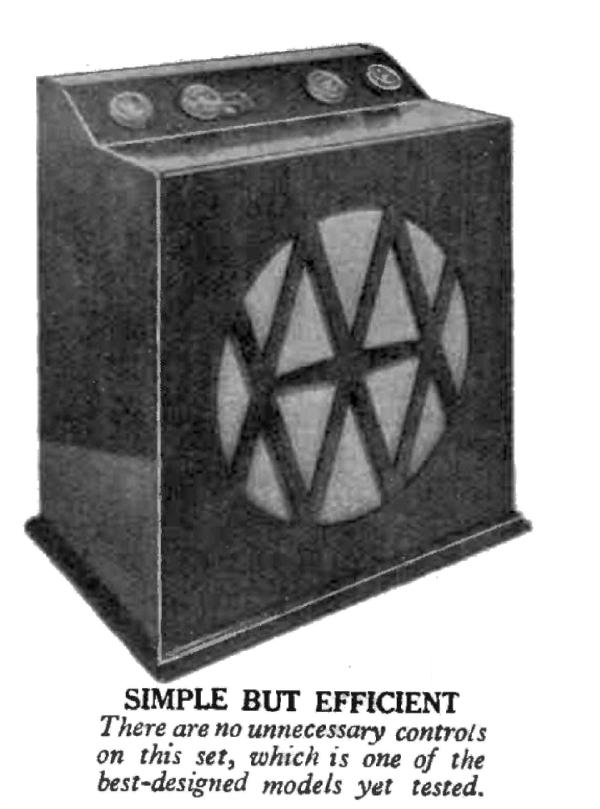murphy: Murphy Portable Four - Product Review, Feb 1931
murphy: Murphy Portable Four - Product Review, Feb 1931

Murphy Portable Four - The selectivity of this portable exceeded our expectations"
Maker:- Murphy Radio, Ltd.
Price:- 17 guineas.
Power Supply:- Batteries. Easy access to the compartment at the back, which includes a 2-Volt accumulator and a standard-capacity 108-volt high-tension battery. The leads for these batteries are neat and durable.
Power Consumption:- A remarkably low total anode current consumption was measured, namely 8.5 milliamperes. The total low-tension current consumption was 0.5 ampere, so the accumulator supplied with the set will last at least 40 hours.
Valve Combination:- A high-frequency amplifier is followed by a detector and two stages of transformer-coupled low-frequency amplification. The first valve is a Mullard PM12 screen grid type, the detector a Mazda HL210, the first low frequency amplifying valve a Mazda HL210, and the power valve a Mullard PM2.
The makers. advance a very interesting argument in favor of four-valve combinations with only one screened-grid best high-frequency amplifier instead of two high-frequency amplifiers. They suggest that with one screened-grid high-frequency amplifier and two transformer-coupled low-frequency amplifiers the total gain might be 126,000, whereas the total gain of a two screened grid set on a similar basis might be 150,000 or very little more.
Type:- This four-valve portable is housed within an upright cabinet. It would rightly be termed transportable since its construction is obviously more suitable for a semi-permanent installation than for true portability.
Controls:- The makers have struck a new note in the arrangement of the controls. Four knobs are arranged in a line with the sloping control panel at the top of the cabinet. The maker's slogan "Making Wireless Simple” has been put into effect.
At the extreme left is a knob for wave changing. An aperture in the dial shows 200-600 " or " 800-2,000 according to its setting. Next is the tuning dial, which rotates a calibrated scale. The medium waves are calibrated in steps of 20 metres and the long wavelengths in steps of 100 metres. We found the set notable for the ease with which stations could be logged.
Next is the reaction knob. An aperture shows marks "0-9" so that the actual degree of reaction can be logged for distant stations. This marking should be of great help to non-technical users. Lastly, on the extreme right is the volume control and through an aperture in this dial can be read 1,2,3,4," so that even the degree of volume can be calibrated. Altogether we must say how very impressed we were with the controls of the Murphy portable. The makers have spared no pains to simplify the operation.
Sensitivity:- We were able to gain some idea of the abilities of this set during a recent evening when both long and medium-wavelength bands were explored. Starting on the long waves, we first logged Huizen at full loud-speaker strength using the maximum settings of the volume and reaction controls. Next came Radio Paris, a very good loudspeaker signal, provided that the volume control was set at its maximum. Then Zeesen, also good. Eiffel Tower did not need reaction, nor did Kalundborg whose stations came in at excellent strength. Lastly, Oslo was logged at fair strength without reaction. Switching over to the medium-wavelength band, we had no difficulty in logging seventeen stations at full loud-speaker strength. Budapest was fair, Vienna was good, Rome very good, as were Stockholm, Katowice, and Toulouse. Hamburg was good and Strasbourg was very good. Dresden. Bordeaux. Bratislava and Turin were all well heard between the two London Regional stations. Below the London National, we got Leipzig, Juan Les Pins, Nürnberg, and Cologne at excellent strength. There were many more stations available, but we logged only those that could be listened to with enjoyment.
Selectivity:- We must frankly confess that the selectivity of this Murphy portable exceeded our expectations London National at 261 had disappeared at 255 and 270 metres, a spread of only 15 metres. London Regional at 356 had gone again at 372 and 350, a spread of 22 metres. Other indications of good selectivity should be mentioned. Langenberg, for example, was received quite clear of the Midland Regional station. Due to the directional property of the frame aerial, we were able to get Hamburg clear of the London Regional. This same property enabled us to get Zeesen clear of Daventry on the long waves. When tuning in all the stations mentioned we noted how easy it was to rotate the cabinet in any desired direction due to the fitting of the smooth working turntable underneath.
Quality:- Considering how low is the anode-current consumption we judged the quality to be very satisfactory. The volume must not be increased beyond a certain well-defined limit owing to the natural limitation of the power valve working at 108 volts. The bass was not fully reproduced, but the tone generally was clear. We prefer this absence of deep bass to the most unnatural presence of artificial bass as produced by box resonance.

Appearance:- Extremely neat. The cabinet work belies the fact that this portable is only 17 guineas. It looks like an expensive set. The fittings are of good quality and the whole set is designed so that it will fit in with the average domestic requirements.
Summary:- For those without an electric-light supply and for those who find difficulty in erecting any sort of aerial wire, the battery-operated portable is the obvious solution. And the Murphy portable is an inexpensive way of fulfilling these requirements. It is one of the best-designed portables we have yet tested, irrespective of price
Wireless Magazine February 1931, page 48.
To thank the Author because you find the post helpful or well done.
